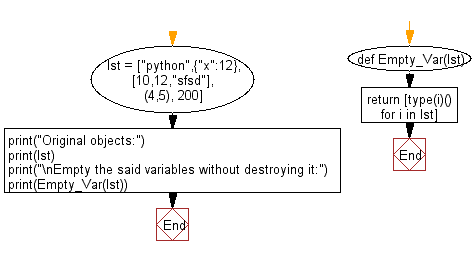Python: Empty a variable without destroying it
Python Basic: Exercise-122 with Solution
Write a Python program to empty a variable without destroying it.
type() returns the type of an object, which when called produces an 'empty' new value.
Sample data: n=20
d = {"x":200}
Expected Output: 0
{}
Sample Solution-1:
Python Code:
n = 20
d = {"x":200}
l = [1,3,5]
t= (5,7,8)
print(type(n)())
print(type(d)())
print(type(l)())
print(type(t)())
Sample Output:
0
{}
[]
()
Visualize Python code execution:
The following tool visualize what the computer is doing step-by-step as it executes the said program:
Sample Solution-2:
Python Code:
def Empty_Var(lst):
return [type(i)() for i in lst]
lst = ["python",{"x":12},[10,12,"sfsd"], (4,5), 200]
print("Original objects:")
print(lst)
print("\nEmpty the said variables without destroying it:")
print(Empty_Var(lst))
Sample Output:
Original objects:
['python', {'x': 12}, [10, 12, 'sfsd'], (4, 5), 200]
Empty the said variables without destroying it:
['', {}, [], (), 0]
Flowchart:

Visualize Python code execution:
The following tool visualize what the computer is doing step-by-step as it executes the said program:
Python Code Editor:
Have another way to solve this solution? Contribute your code (and comments) through Disqus.
Previous: Write a Python program to determine if variable is defined or not.
Next: Write a Python program to determine the largest and smallest integers, longs, floats.
What is the difficulty level of this exercise?
Test your Programming skills with w3resource's quiz.
Python: Tips of the Day
Find current directory and file's directory:
To get the full path to the directory a Python file is contained in, write this in that file:
import os dir_path = os.path.dirname(os.path.realpath(__file__))
(Note that the incantation above won't work if you've already used os.chdir() to change your current working directory, since the value of the __file__ constant is relative to the current working directory and is not changed by an os.chdir() call.)
To get the current working directory use
import os cwd = os.getcwd()
Documentation references for the modules, constants and functions used above:
- The os and os.path modules.
- The __file__ constant
- os.path.realpath(path) (returns "the canonical path of the specified filename, eliminating any symbolic links encountered in the path")
- os.path.dirname(path) (returns "the directory name of pathname path")
- os.getcwd() (returns "a string representing the current working directory")
- os.chdir(path) ("change the current working directory to path")
Ref: https://bit.ly/3fy0R6m
- New Content published on w3resource:
- HTML-CSS Practical: Exercises, Practice, Solution
- Java Regular Expression: Exercises, Practice, Solution
- Scala Programming Exercises, Practice, Solution
- Python Itertools exercises
- Python Numpy exercises
- Python GeoPy Package exercises
- Python Pandas exercises
- Python nltk exercises
- Python BeautifulSoup exercises
- Form Template
- Composer - PHP Package Manager
- PHPUnit - PHP Testing
- Laravel - PHP Framework
- Angular - JavaScript Framework
- Vue - JavaScript Framework
- Jest - JavaScript Testing Framework
